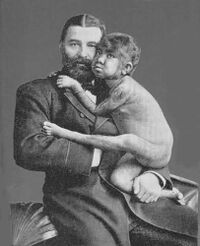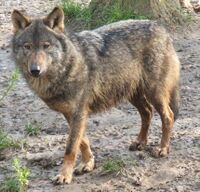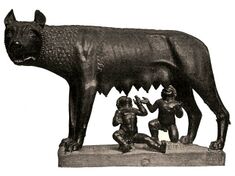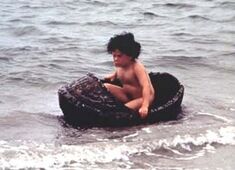Feral child
A feral child is a human youth who was lost, abandoned, abducted, or otherwise separated from its human parents and its natural environment as an infant and, to the astonishment of all, has subsequently survived, having been raised by wild animals, such as chimpanzees, wolves, aardvarks, or sea monkeys.
There are many stories of feral children having been discovered by scientists who happen to need money, and whose stories turn out to be as lucrative for the poor scientist as he had hoped. In fact, by far the most important contribution that feral children have made to the field of human development studies has been to provide researchers with the fame and attention they need to continue their work and pay for their Bentleys.
Types of feral children
There are many types of feral child. Four particular types stand out, however, for their novelty, ubiquity, absurdity, and/or humorousness.
Chimp child
The chimp child is characterized by distrust of human contact, curiosity, an extreme love for bananas, and delight in wearing striped bell-boy costumes.
Famous chimp children include Bello, the Nigerian Chimp Boy, who was raised by chimps until he was two, but was still throwing feces by the time he died at 11, and Robert, the Ugandan monkey boy, whose monkey mamma loved him so that she tried to protect him from capture by the scientist who found him. Of course, the scientist had no trouble killing her and saving the boy, and was handsomely rewarded for his brave deed.
Wolf child
The wolf child is characterized by distrust of human contact, howling at the moon, eating without his hands, and impersonating grandma.
Of all wild animals, wolves are the fondest of human babies, and are most apt to care for an abandoned human child. There are more wolf-raised children in the world than children raised by scientists. This has caused many wolf-raised children to be ignored by the scientists finding them, because they don't hold the same exploitation promise as other types of feral children.
The wolf child usually rises to alpha-male status in the pack in which he is raised (even if he is a she - wolves can't discern human gender). Most wolf children have been found in India, which has led many to believe that Indian wolves are the kindest wolves in the world, or that Indian human development scientists are in the most financial need.
Aardvark child
The aardvark child is characterized by distrust of human contact, ant-eating, extreme ugliness and being really early in alphabetical listings.
There have never been any actual claims of Aardvark Children, however. This fact is puzzling, because the lucrative vs. ludicrous ratio of such a thing is very high. Even if as much as 90 percent of the human development science community were to pass such a claim off as complete nonsense, the gullible public would devour such a story, and the returns enjoyed by the Indian scientist making the claim would be enormous. For this reason, we include this type of feral child here, hoping that one day some Indian scientist free of the shackles of a conscience will take the idea and run with it. Such fun that would be.
Sea monkey child
The sea monkey child is characterized by distrust of human contact, amazingly coming instantly to life in regular household tap water, playful monkey-like behavior, and extreme disapointment at the actual results. The sea monkey child is by far the most pitiful of feral children.
The most devastating cases of children raised by sea monkeys will break your heart. The image is of a hopeful five-year-old, staring wide-eyed at a small square aquarium full of tap water, waiting for the sea monkeys to look at him, smile for him, and dance and play for him, but actually barely even ever seeing anything happen. These children sit and stare at the tanks for the rest of their lives, their wide-eyed hope turning slowly to egregious disappointment upon learning that his new family is really just mindless squirming brine. Artemia salina x nyos, to be exact.
Other types
There are rare instances of children being raised by other types of non-human adoptive parents. Some notable cases are Daniel, the Peruvian goat boy, the Cooch Bahar Jackal Girl, and the very frightening case of Jason Voorhees, who was raised in the woods by 70s-era hockey goalies.
Feral children in history
Despite the inherent ostracism and alienation that is associated with it, being raised by wild animals has been known historically to cause super-human powers.
A pair of feral twins, for instance, founded the empire of Rome (see left). Tarzan, a feral child who remained feral into adulthood, possessed super-human strength and endurance, though in a similar case, a man also of the jungle, named George, suffered debilitating eyesight issues, always having to be warned to "watch out for that tree". Another famous feral child, Mowgli, had extraordinary singing and dancing abilities.
Then there is the heart-warming tale of the baby who was abandoned in the icy waters of the North Atlantic, near the Irish Isle of Roan Inish, and subsequently raised by seals (right). This is not the tale of any extraordinary feat performed by him, however. The incredible fact of this little child's feral life is that inexplicably, his older sibling and cousin, not more than teenagers, mind you, somehow gained the incredible ability to completely clean, repair and repaint an entire homestead by themselves. In secret. This has never been known to happen before in the history of the human race.
The most extraordinary example of the feral child, however, is the incredible case of Valentine Michael Smith, who was raised by Martians and subsequently brought back to Earth. Despite having developed keen psionic abilities as a result of his unusual upbringing, the real story is as tragic as it is compelling. Like the story of every feral child, the story of Smith's attempts to reintegrate with Earth society is the story of the clash between human cultural intransigence and its adaptability.
Feral child mania
Despite the tragedy of these stories, the mystique of the feral child has always captivated our imaginations. The public appetite for these stories seems insatiable, so the market for greedy scientists will continue to flourish.
However, despite the novelty and excitement of it, there is as yet no known way for a person to create a feral child by choice, if they should want to. Attempting to do so is strongly discouraged, as the most likely result will be your young one's death by mauling. Scientists, while they rake in lecture circuit money with their stories about how their discoveries managed to survive without human nurturing, have yet to discover a means of determining if a given wild animal is mother or father material.
You may still indulge your extreme feral child obesession, however, by purchasing this lovely "Three Wolf Moon" T-shirt. It will give you feral child powers, like Tarzan. You will not be the first.
| Featured version: 22 August 2011 | |
| This article has been featured on the main page. — You can vote for or nominate your favourite articles at Uncyclopedia:VFH. | |






